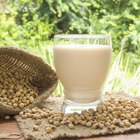ajafoto/iStock/GettyImages
Two Easy Options for One Indispensable Ingredient
Milk is a remarkably useful, nutritious and versatile substance that provides protein and a variety of minerals to many recipes. Unfortunately, it's also highly perishable, so if you don't use it frequently, it can be inconvenient to keep in your fridge. For baking, sauces or even emergency use, dry milk powder can be a better option. It's available in instant and non-instant versions: Both are shelf-stable and suitable for dry storage in your pantry, and there are only minor differences between them.
Dry Milk Powder
Modern milk powder is produced industrially, but the idea's been around for a long time. Famed traveler Marco Polo described how nomadic Tartar warriors made dried milk by boiling it to a paste, then drying the paste in the hot sun. Today, the milk--usually non-fat milk, which stores better--is pasteurized and concentrated, and then dried by spraying droplets onto a hot roller or into a chamber filled with hot, dry air. The instant and non-instant versions are prepared and used differently.
Instant Milk Powder
Instant milk powder is pasteurized in the same way as liquid milk--at a high temperature for a short time, which minimizes the effect on its flavor. It's then evaporated in a vacuum chamber, which removes most of the moisture without giving it a "cooked" flavor. Instant milk powder is usually made by spraying droplets of concentrated milk into a heated chamber. It's relatively light and bulky, and feels gritty when rubbed between the fingers. It mixes quickly in cold water, reconstituting into non-fat skim milk. For drinking purposes, its flavor is best when it's refrigerated overnight after mixing.
Non-Instant Milk Powder
Non-instant milk powder is also made by concentrating the milk to remove most of its water. It follows a process more similar to the one used for evaporated milk, which cooks out the moisture at a higher temperature than the process used for instant skim milk. This gives it a discernible "cooked" flavor when it's reconstituted, very much like the taste of evaporated milk. Some brands of non-instant milk use the heated-chamber method of producing powder, but most spray the droplets of concentrated milk onto a heated roller. This produces a finer, denser powder that's slower to reconstitute. Most non-instant milk is also non-fat, although whole-milk versions are available.
Using Milk Powder
Use instant non-fat milk powder to make liquid skim milk, or as an ingredient in baked goods and other dishes. Instant milk powder, like liquid milk, contains enzymes that can sometimes interfere with yeasts or with gluten development. That's why bakers, especially bread bakers, often prefer to use non-instant milk powder. It's the equivalent of the "scalded" milk called for in many vintage recipes, cooked enough to deactivate the troublesome enzymes. In small quantities, the two can be used interchangeably in most recipes. Non-instant milk is denser and more concentrated. Making a quarter cup of liquid milk takes a tablespoon of instant milk, but only three-quarters of a tablespoon of non-instant.
Related Articles

How to Make Milk Powder Non-Instant

How Much Powdered Milk Makes 1 Cup?

Cheeses Similar to Feta

Whole Milk Vs. Lactaid Milk

How to Dissolve Non-Instant Milk Powder

Can I Substitute Dry Milk Powder for ...
The Difference Between ...

Corn Starch Vs. Baking Powder in Cooking

What Makes Homemade Chai Curdle?

What Are Rennet Tablets?

Tapioca Flour Vs. Quick Cooking Tapioca

Difference Between Fermented Milk & ...
How to Scald Milk for Cooking

Skim Milk Powder Nutritional Information

How to Use Powdered Milk for Baking

How to Cook Gravy With Granulated ...

Does Soaking Elk Roast in Milk Do ...

What Is Freeze-Dried Coffee?

Soy Milk Powder Vs. Liquid

Can I Use Regular Milk Instead of ...
References
- On Food and Cooking: The Science and Lore of the Kitchen; Harold McGee
- U.S. Dairy Export Council: Reference Manual for U.S. Milk Powders
- USA Emergency Supply: Instant Powdered Milk
- Food Storage Made Easy: Let's Talk About Powdered Milk!
Writer Bio
Fred Decker is a trained chef and prolific freelance writer. In previous careers, he sold insurance and mutual funds, and was a longtime retailer. He was educated at Memorial University of Newfoundland and the Northern Alberta Institute of Technology. His articles have appeared on numerous home and garden sites including GoneOutdoors, TheNest and eHow.